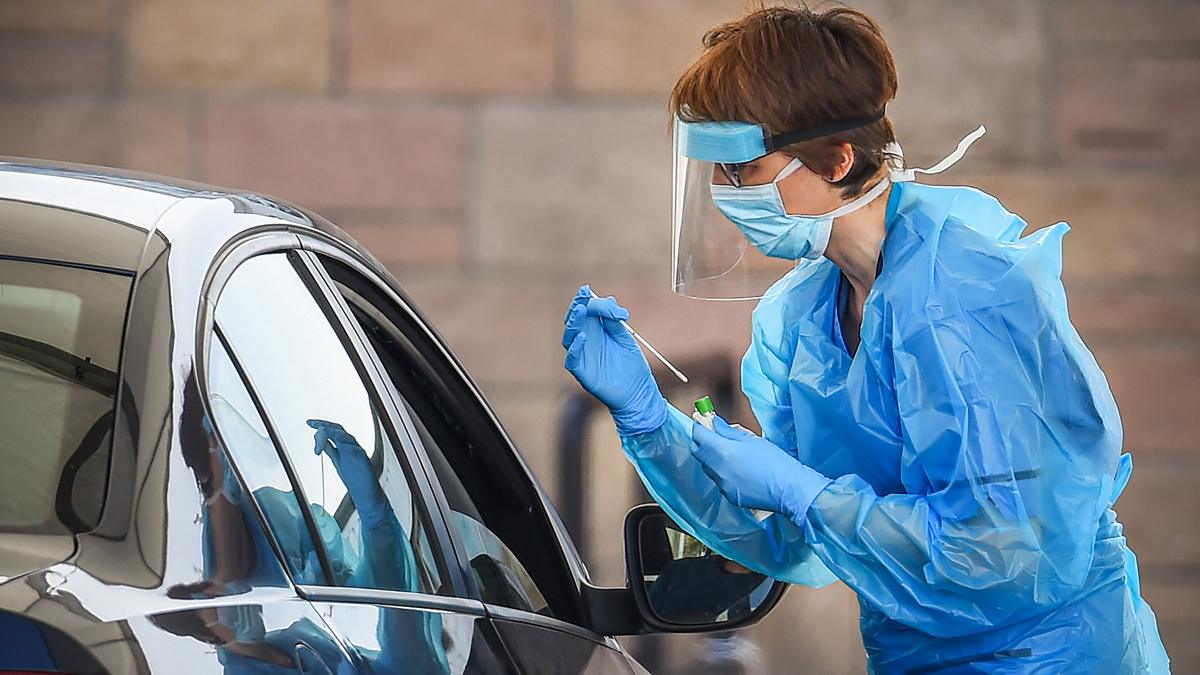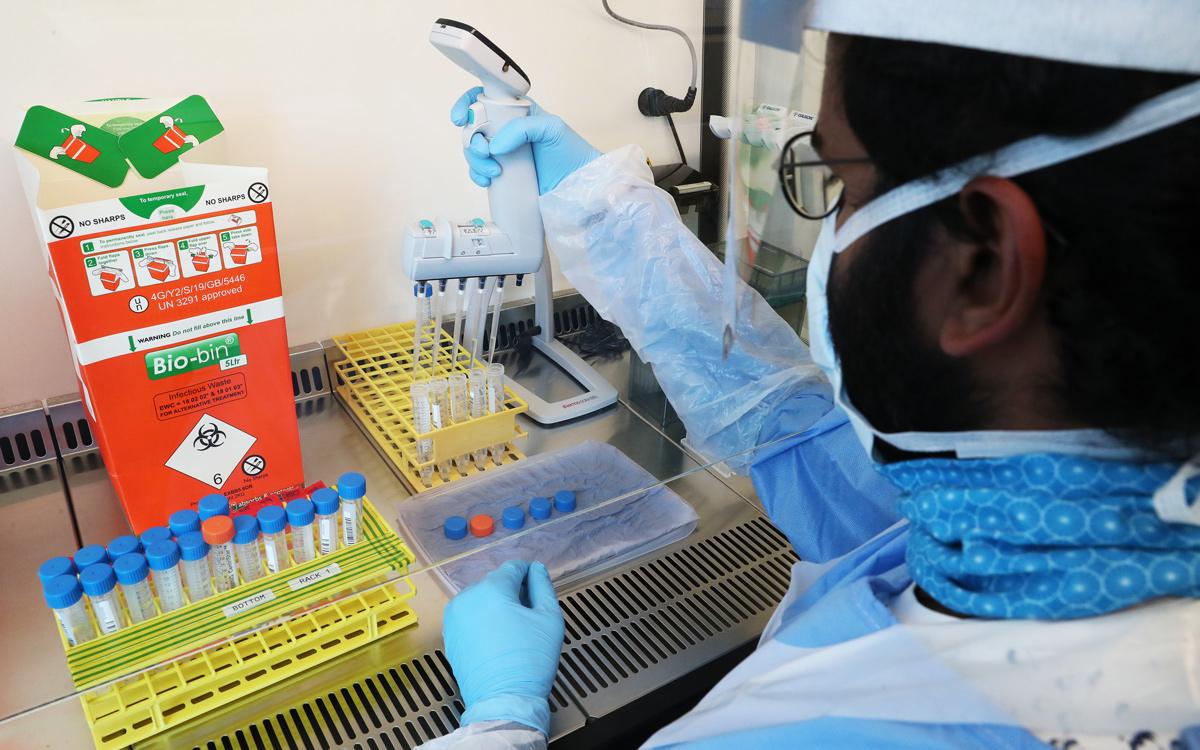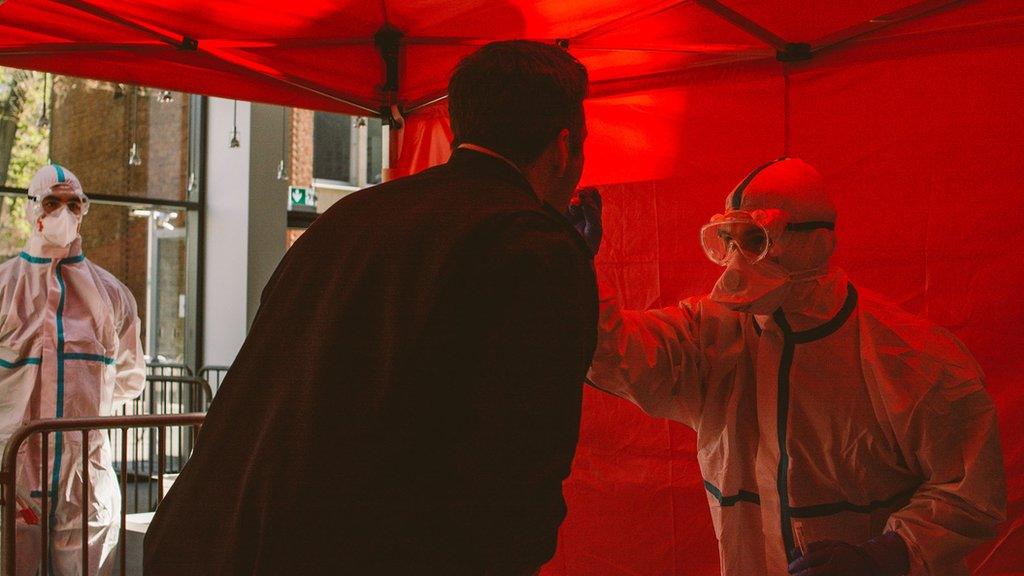Coronavirus testing: Government claims on test centres and international comparisons fact-checked
- Published

The government is facing criticism over its "world-beating" coronavirus testing system after people reported struggles to get tests, including being offered slots at testing sites a long way away.
Prime Minister Boris Johnson and various cabinet members have been defending the scheme, and have claimed that testing capacity is increasing and that the average trip to get tested isn't that far.
We've looked at five of their claims.
Claim 1. Matt Hancock: "The average distance travelled to a test site is now just 5.8 miles"
The health secretary made this claim in the House of Commons - last week, he said the average distance was 6.4 miles.
Initially, the Department of Health and Social Care (DHSC) did not release the data on this - despite our repeated requests to see it. Now it has released some of it., external
It supports Mr Hancock's claims. It states that the median distance travelled (that's the point at which half the trips were shorter and half longer) in England in the last week was 5.8 miles. This was down from 6.4 miles the previous week.
It also shows that the 5% of people travelled more than 47 miles away for a test - that would make a round-trip of 94 miles. How far are people travelling to get tested?
It counts trips made to regional test centres, local walk-ins and mobile test units.
It doesn't supply the numbers of people but we know 360,000 tests were processed from these sites, external in the latest week. 5% of this figure would be around 18,000 people who travelled nearly 50 miles to a test centre (although some may have got more than one test).
The data also shows that most people (75%) travelled around 13 miles each way.

The DHSC has also given us details about how it worked the distances out. It uses a straight line from someone's location to the test site "as the crow flies".
But this doesn't take into account that most roads are not in a straight line between the two points - so average distance actually travelled will be higher.
For example, if someone was to drive between the BBC offices in central London and the Wembley testing facility, the exact distance between the two is 5.5 miles (8.9km). However, once you take into account the actual roads, this increases to about eight miles.
Finally, the data only records people who booked a test. It doesn't tell us how many tried to get one, decided the one they were offered was too far away and didn't take it.
Claim 2. Boris Johnson: "We've conducted more tests than any other European country"
As of 30 August, the UK had processed just over 15m antigen tests, - the ones which tell you whether you currently have coronavirus.
This total is higher than any other country in Europe, according to data collected by European Centre for Disease Prevention and Control (ECDC), an EU agency.
Their figures show that, by this date:
Germany processed 12.3m tests
France processed 7.4m tests
Comparisons between countries will not always be perfect, because some countries report less often and there might be some differences in methodology.

A coronavirus testing centre in Cologne's Rautenstrauch Joest museum
Boris Johnson has also claimed that the UK is testing more per head of population than France, Germany and Spain.
Looking at this measure allows for differences in population size between countries.
Mr Johnson is right - according to ECDC data on tests per 1,000 people for the week ending 30 August:
UK - 19 tests per 1,000
France - 13 tests per 1,000
Germany - 13 tests per 1,000
Spain - 12 tests per 1,000
The data also shows that four European countries rank higher than the UK, including Denmark on 42 tests per 1,000.
Claim 3. Priti Patel: "The government has been consistently increasing testing capacity, but also laboratory capacity"
The home secretary is correct that government data shows that both testing capacity and laboratory capacity have increased considerably since the beginning of the pandemic.
However, there has been a sizeable gap between how many tests labs are able to process ("capacity") and the number of tests actually processed.
For example, on 10 September, labs in the UK would have been able to process 244,000 antigen tests, which indicate if you currently have the virus, but processed 204,000. This means, in theory, labs could have processed results for 40,000 more tests.

Last week, Sarah-Jane Marsh, a director of the government's test-and-trace programme in England, confirmed there was a problem with the labs, offering a "heartfelt apology" to those who couldn't get a test.
"All of our testing sites have capacity, which is why they don't look overcrowded, it's our laboratory processing that is the critical pinch-point," she said.
Data on backlogs in labs is not publicly available, but on Tuesday Health Secretary Matt Hancock said the backlog was "less than a day's capacity". This means it could be anywhere up to 244,000.
He added that this has been driven by a surge in demand as children go back to school and adults return to work.
We have asked the government why - in a system with more lab capacity than actual tests carried out - there is a backlog, but have had no response.
Claim 4. Boris Johnson: "89% of those who have in-person tests get them [results] the next day."
The latest test return times in England we have, are for the week to 9 September - the figure is actually for people getting results within 24 hours rather than the next day.
The figure Mr Johnson appears to be referring to is the proportion of test results published within 24 hours of them being received by a laboratory - it was 88.8% according to the latest figures, external.

A SIMPLE GUIDE: How do I protect myself?
AVOIDING CONTACT: The rules on self-isolation and exercise
LOOK-UP TOOL: Check cases in your area

But this excludes the time it takes to get the test to the lab, and it's for pillar 1 tests, which are for people with a clinical need and are processed in Public Health England labs and NHS hospitals.
For pillar 2 tests, the ones for the wider population and run by private labs, external, the median turnaround time from taking a test at a regional test site to getting the result was 27 hours, which means half of tests took longer than that, and half took less time.
For mobile testing units that figure was 26 hours, but for satellite testing centres it was 97 hours.
Satellite tests are ones which are processed by private labs and sent to places like care homes or hospitals. The government says tests in these settings are often conducted over multiple days. This means that someone might take a test a few days before it is collected.
Claim 5. Priti Patel: "There is a lot more mobile testing that's taking place, particularly in lockdown areas, but also home testing kits being sent to people"
Outside permanent drive-through testing sites, people can also get testing kits delivered to their home or visit mobile testing sites, which move around according to demand.
Ms Patel is correct that there has been an increase in both of these, doubling in number since the end of May.

It is difficult to confirm whether more tests are taking place in lockdown areas because - again - the government does not release this data by local authority. We also don't know how many people have asked for tests but have not been able to get them when they want them.
On 15 September, the health secretary said 9,278 Pillar 2 - or commercially run - tests were carried out in the top 10 most affected areas of the country. That equates to about 7.5% of all tests on an average day.
These 10 areas make up 5% of the population, meaning they received proportionally more tests.


